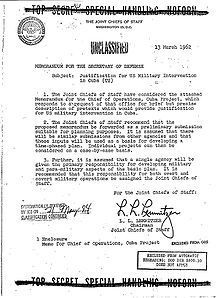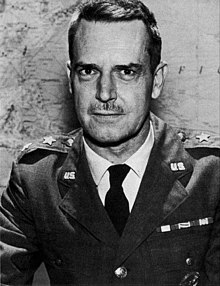Operation Northwoods
The proposals called for CIA operatives to both stage and commit acts of terrorism against American military and civilian targets, blame them on the Cuban government, and use them to justify a war against Cuba.
The possibilities detailed in the document included the remote control of civilian aircraft which would be secretly repainted as US Air Force planes,[2] a fabricated 'shoot down' of a US Air Force fighter aircraft off the coast of Cuba, the possible assassination of Cuban immigrants, sinking boats of Cuban refugees on the high seas,[3] blowing up a U.S. ship, and orchestrating terrorism in U.S.
[5][6][7] Fidel Castro had taken power in Cuba in 1959 and began allowing communists into the new Cuban government, nationalizing U.S. businesses and improving relations with the Soviet Union, arousing the concern of the U.S. military due to the Cold War.
It stated: The desired result from the execution of this plan would be to place the United States in the apparent position of suffering defensible grievances from a rash and irresponsible government of Cuba and to develop an international image of a Cuban threat to peace in the Western Hemisphere.Several other proposals were included within Operation Northwoods, including real or simulated actions against various U.S. military and civilian targets.
Although part of the US government's anti-communist Cuban Project, Operation Northwoods was never officially accepted; it was authorized by the Joint Chiefs of Staff, but then rejected by President Kennedy.
The main Operation Northwoods proposal was presented in a document titled "Justification for U.S. Military Intervention in Cuba (TS)," a top secret collection of draft memoranda written by the Department of Defense (DoD) and the Joint Chiefs of Staff (JCS).
Gen. Edward Lansdale, the document listed methods, such as false flag provocations, that the authors believed would garner support for U.S. military intervention in Cuba.
[17] As the U.S. Department of Defense report noted: Any of the contrived situations described above are inherently, extremely risky in our democratic system in which security can be maintained, after the fact, with very great difficulty.
A JCS/Pentagon document, a memo by Lansdale entitled MEETING WITH THE PRESIDENT, 16 MARCH 1962, reads: "General Lemnitzer commented that the military had contingency plans for U.S. intervention.
Following presentation of the Northwoods plan, Kennedy removed Lemnitzer as Chairman of the Joint Chiefs of Staff, although he became Supreme Allied Commander of NATO in January 1963.
A rift had already developed during Kennedy's disagreements with the service chiefs over the Cuban Missile Crisis in October 1962 and flared up again with his June 10, 1963 announcement of a unilateral U.S. Test Ban Treaty.



